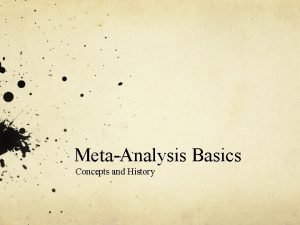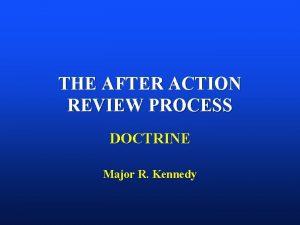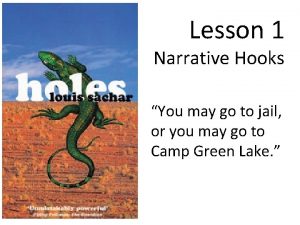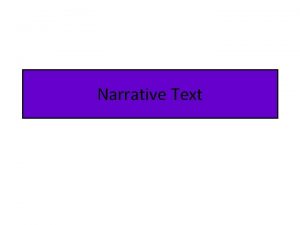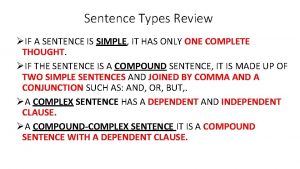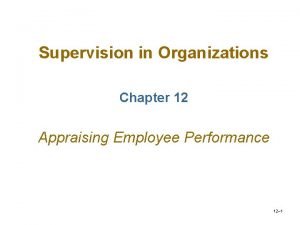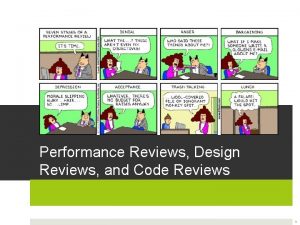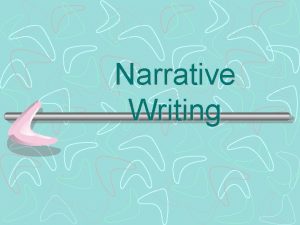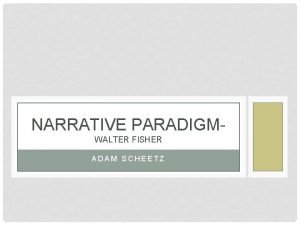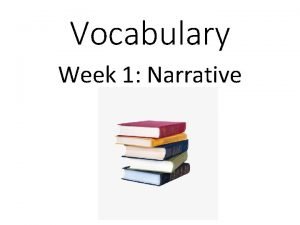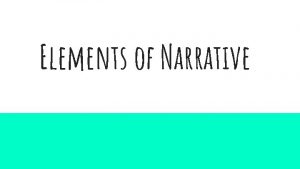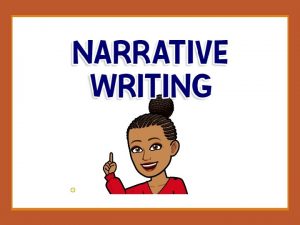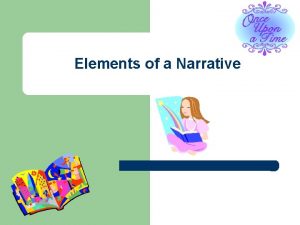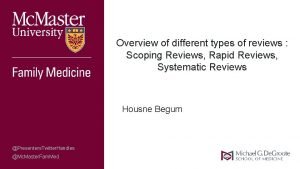Metaanalysis Types of reviews Narrative review vs metaanalysis





























- Slides: 29

Meta-analysis

Types of reviews �Narrative review vs. meta-analysis vs. integrative data analysis �Univariate vs. bivariate vs. multivariate vs. SEM �When was the first meta-analysis? �When was the term first used? �What are the advantages of quantitative reviews? �What are problems with them?

Steps to meta-analysis

1. Define your variables/question � 1 df contrasts (or multivariate meta-analysis or SEMbased meta-analysis) �What is a contrast?

2. Decide on inclusion/exclusion criteria �What factors do you want to consider here?

3. Collect studies systematically �Where do you find studies? �File drawer problem �Gray lit

4. Code your studies �What should you code? �Inter-rater reliability �If there is more than 1 effect per study, what do you do? �What does the sign mean on an effect size? �What are small, medium, and large effects? �How can you convert from one to another? �r or d? �http: //www. soph. uab. edu/Statgenetics/People/MBeas ley/Courses/Effect. Size. Conversion. pdf

Families of effect sizes—d family � 2 group comparisons (difference between the means) �Cohen’s d (with various subscripts) �Hedge’s g �Glass’s d or delta �Point biserial r �Within vs. between-participants designs �https: //www. frontiersin. org/articles/10. 3389/fpsyg. 2013. 00863/full Lakens, 2013 (Table 1) �Probability of superiority or common language ES

Families of effect sizes—R family �Continuous or multi-group (proportion of variability) �η 2 �ηp 2 �ηG 2 �ω2 and its parts �r, fisher’s z, R 2, adjusted R 2 �difference between η 2 and R 2 family �https: //www. frontiersin. org/articles/10. 3389/fpsyg. 2013. 00863/full Lakens, 2013 (Table 2)

Calculate for PO effect

Other effect sizes �Nonparametric effect sizes �Nonnormal data: convert z to r or d �Categorical data: � Rho � Cramer’s V � Goodman-Kruskal’s Lambda �How can you increase your effect sizes?

CIs �How can you calculate confidence intervals around your effect sizes? �http: //daniellakens. blogspot. com/2014/06/calculatingconfidence-intervals-for. html �https: //thenewstatistics. com/itns/esci/ �http: //www. cem. org/effect-size-calculator �https: //www. aggieerin. com/shiny-server/ �What type (e. g. , %) CI should you report?

Interpretation of effect sizes �Recommended for at least most important findings �Benchmarks? �SD units �Practical or clinical significance and compare to lit �PS or common language effect size �U �Binomial effect size display �Relative risk �Odds ratio �Risk difference

5. Combine effect sizes �When should you do fixed vs. random effects? �Should you weight effect sizes, and if so, on what? �How can you deal with dependent effect sizes? �Hunter and Schmidt method vs. Hedges et al. method

6. Calculate confidence intervals �Credibility intervals vs. confidence intervals

7. Check for/correct for biases �m-a effect = True effect + effect of pub and exp bias �Outliers �Correct for unreliability

Publication bias assessments �Rosenthal’s fail-safe N �# studies needed at p <. 05= (K/2. 706) (K(mean Z squared) = 2. 706) �Z = Z for that level of p � K = number of studies in meta-analysis �Funnel plot (Egger’s test) �Rank correlation test for pub bias �Correlation between n and ES �Cumulative meta-analysis �Sensitivity analyses

Fig. 3. Funnel plots of 11 (subsets of) meta-analyses from 2011 and Greenwald, Poehlman, Uhlman, and Banaij (2009). Marjan Bakker et al. Perspectives on Psychological Science 2012; 7: 543 -554 Copyright © by Association for Psychological Science

Publication bias corrections �Trim and fill �Sensitivity analysis �WAPP-WLS �PET-PEESE (Figure 1; van Elk et al. , 2015) � Critiques of PET-PEESE, http: //datacolada. org/59 �p-uniform � 3 PSM �Cumulative meta-analysis �Bayesian approaches (e. g. , BALM)

p-curves �p-curve analysis (Figure 1; Simmons & Simonsohn, 2017) � Critiques of p-curves �www. p-curve. com �Which do Carter et al. recommend? �What effects did QRPs have on meta-analytic estimates?

8. Look at heterogeneity of effect sizes �Chi-square test �I 2 (measure based on Chi-square) �Cochran’s Q or Hedges Q �Standard deviations of effect sizes �Stem and leaf plot �Box plot �Forest plot

Forest plot

9. Look for moderators �What are common moderators you might test? �How do you compare moderators?

“little ‘m’ meta-analysis” �Comparing and combining effect sizes on a smaller level—when might you want to do this? �How would you do it? �Average within-cell r’s with fisher z transforms �To compare independent r’s: Z = z 1 -z 2/sqrt ((1/n-3) + (1/n-3)) �To combine independent r’s: z = z 1+z 2/2

Write-up �Inclusion criteria, search, what effect size �Which m-a tech and why �Graphs �Stem and leaf plots of effect sizes (and maybe mods) �Forest plots �Stats on variability of effect sizes, estimate of pop effect size and confidence/credibility intervals �Moderators �Publication bias analyses

Significance and effect sizes �What is the problem with just using p-levels to determine whether one variable has an effect on another? �Be careful with comparisons--sample results: �For boys, r (87) =. 31, p =. 03 �For girls, r (98) =. 24, p =. 14 �How does sample size affect effect size? Significance? �Why are effect sizes important? �What is the difference between statistical, practical, and clinical significance?

What should you report? � 2 group comparison—treatment vs. control on anxiety symptoms � 3 group comparison—positive prime vs. negative prime vs. no prime on number of problems solved � 2 continuous variables—relationship between neuroticism and goal directedness � 3 continuous variables—anxiety as a function of selfesteem and authoritarian parenting � 2 categorical variables—relationship between answers to 2 multiple choice questions

Coming up �Next class: �Replication readings (don’t get in the weeds of replicated studies) �Meta-analysis assignment (updated 3/23)

The next week: Presentations for proposal �Formal presentations—dress nice, stand up �No more than 12 minutes �I’ll take notes and send to you �Go through your FINAL plan for your study— background, method, expected results, and discussion �Graded on: �Presentation style �Slide quality �Ability to answer questions �Clarity and completeness
 What is metaanalysis
What is metaanalysis Comprehensive metaanalysis
Comprehensive metaanalysis Narrative review vs systematic review
Narrative review vs systematic review Search strategy example
Search strategy example Narrative review vs systematic review
Narrative review vs systematic review The two doctrinal types of after action reviews are:
The two doctrinal types of after action reviews are: Fictional personal narrative
Fictional personal narrative Personal narrative vs fictional narrative
Personal narrative vs fictional narrative Chapter review motion part a vocabulary review answer key
Chapter review motion part a vocabulary review answer key Ap gov final review
Ap gov final review Haiku poem
Haiku poem What are the 4 types of text?
What are the 4 types of text? Synecdoche literary definition
Synecdoche literary definition Types of narrative writing
Types of narrative writing Types of narrative writing
Types of narrative writing Kinds of story
Kinds of story Types of narrative hook
Types of narrative hook Types of narrators
Types of narrators Types of narrative poems
Types of narrative poems A. narrative text
A. narrative text Types of nonfiction genres
Types of nonfiction genres Theoretical and conceptual framework in research example
Theoretical and conceptual framework in research example Sentence types review
Sentence types review Riva insight
Riva insight Free spirit israel
Free spirit israel Reputation marketing tampa
Reputation marketing tampa Testojack 300 side effects
Testojack 300 side effects Dr gregg eloundou reviews
Dr gregg eloundou reviews Adjective rating scale appraisal
Adjective rating scale appraisal Shire oak academy reviews
Shire oak academy reviews
